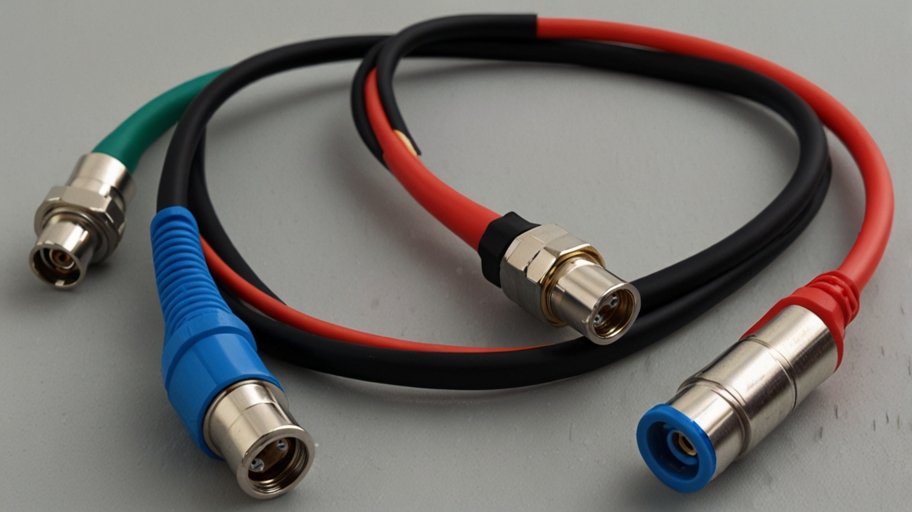Introduction 4.3-10 connector cable assembly
New connector systems must be developed because telecommunications and RF technology require smaller devices that deliver better performance and efficiency. Among the many connectors available in the industry, the 4.3-10 connector cable assembly has gained prominence due to its superior electrical performance, reduced size, and enhanced intermodulation characteristics. This article delves into the technical specifications, applications, advantages, and challenges associated with the 4.3-10 connector cable assembly, providing an exhaustive exploration of its significance in modern RF applications.
Technical Specifications of 4.3-10 Connector Cable Assembly
The 4.3-10 connector cable assembly is engineered to meet the demanding requirements of high-frequency signal transmission. The main characteristic of this connector is its operational efficiency, which ranges from direct current to 6 GHz. 4G and 5G infrastructure, together with high-performance communication networks, rely on the 4.3-10 connector because of its wide frequency response range.
The impedance of the 4.3-10 connector cable assembly is precisely controlled at 50 ohms, ensuring minimal signal loss and maximum power transfer. RF systems require exceptional attention to impedance because mismatches between signals and their impedances cause notable reflections, which decrease system performance. A key attribute of this connector is its low passive intermodulation (PIM) response, which exceeds -166 dBc and serves essential purposes during high-density RF signal operations.
Another defining aspect of the 4.3-10 connector cable assembly is its excellent power-handling capability. Different frequency bands enable the configuration to operate between 100W to 500W range in power output. The insulation resistance and consistent electrical performance across diverse temperatures are aided by PTFE material, which serves as the dielectric substance inside the connectors.

Mechanical and Environmental Characteristics
The 4.3-10 connector cable assembly is designed for robust performance in various environmental conditions. The compact layout of this connector reduces to 30% smaller dimensions compared to 7/16 DIN standard connectors. The reduced size of 4.3-10 connectors works efficiently in base station antennas and distributed antenna systems (DAS) when space is limited.
Three coupling methods are available in the connector through its screw push-pull and hand-screw configuration. Customers can select one of several installation choices through the unique coupling variations to match their demands and personnel preferences. Quick tool-free connections work best with the push-pull version of this connector, yet the threaded variant provides maximum stability for connection.
The 4.3-10 connector cable assembly is also known for its exceptional environmental sealing capabilities. Manufacturers rate their 4.3-10 connectors as IP67 or IP68 to achieve high levels of dust and water resistance. These connectors supply reliable performance in outdoor conditions that demand protection from rough weather elements. The connectors endure tests to determine their mechanical durability by maintaining their performance qualities throughout more than 500 successive mating operations.

Applications of 4.3-10 Connector Cable Assembly
The 4.3-10 connector cable assembly finds extensive applications in telecommunications, broadcast systems, radar equipment, and industrial automation. The cellular base station stands as one of its main deployment areas because technicians use the 4.3-10 connector cable assembly to join antennas with feeders and RF units. The low intermodulation characteristics of the 4.3-10 connector cable assembly make it particularly well-suited for multi-carrier cellular networks, where signal clarity is paramount.
The connectors serve multiple purposes by connecting telecom systems in addition to serving test and measurement instruments. The electrical stability, along with repeatable performance, delivers precise signal transfer, and this characteristic is vital for testing environments both in laboratories and field applications. Furthermore, the aerospace and defense sectors leverage the 4.3-10 connector cable assembly for secure RF signal transmission in radar and communication systems, where reliability is non-negotiable.
The medical industry has also adopted the 4.3-10 connector cable assembly for diagnostic imaging and medical telemetry applications. Its signal quality consistency combined with minimal interference properties makes this connector beneficial for medical devices that need precise data transmission.
Manufacturing and Material Considerations
The construction of the 4.3-10 connector cable assembly involves meticulous material selection to ensure optimal electrical and mechanical performance. In order to achieve excellent conductivity and resistance against corrosion, the outer conductor consists of stainless steel or brass materials that receive high-quality nickel or silver plating. High-purity copper or specific copper alloys serve as the material for the center conductor because they enable peak signal transmission capabilities.
The choice of cable used in the 4.3-10 connector cable assembly also plays a crucial role in determining overall performance. 4.3-10 connectors perform optimally with low-loss coaxial cables LMR-400 or RG-series due to their ability to reduce signal degradation. The reduction of electromagnetic interference requires multi-layer shielded configurations to achieve effective shielding of the system.

Advantages of 4.3-10 Connector Cable Assembly
One of the most significant advantages of the 4.3-10 connector cable assembly is its superior PIM performance. Modern RF systems require efficient intermodulation distortion control because it ensures signal clarity and network efficiency optimization. Precision connector engineering enables the production of tight mechanical tolerance systems that decrease undesirable signal interference.
Simple installation and easy maintenance make up this cable assembly’s other benefits. Unlike larger connector types, the 4.3-10 connector cable assembly is easier to handle, particularly in densely packed installations. The network component deployment speed increases through multiple coupling mechanisms, which enables fast reconfiguration of the installed network elements.
Durability is also a key benefit of the 4.3-10 connector cable assembly. The rugged design, along with the high-quality materials in this product, provides excellent resistance against environmental stressors such as temperature extremes, humidity, and mechanical vibrations. Network operators and equipment manufacturers who need their RF connections to last long term should view the 4.3-10 connector cable assembly as a strategic investment.
Challenges and Considerations
Despite its numerous advantages, the 4.3-10 connector cable assembly does present some challenges. Existing infrastructure compatibility stands as the primary concern when evaluating 4.3-10 connector cables. These connectors give excellent performance, but users need conversion equipment alongside transitional hardware to operate with networking systems that utilize previous connector models.
The price of this component should be taken into account when making any decision. The high-precision manufacturing processes and premium materials used in the 4.3-10 connector cable assembly contribute to a higher price point compared to traditional RF connectors. The expense of 4.3-10 connector cable assemblies is compensated by their enhanced operational capabilities and extended operating life.
Additionally, proper handling and installation techniques must be observed to maintain the integrity of the 4.3-10 connector cable assembly. Improper torque force combined with surface contamination or mechanical damage to mating connections leads to reduced performance quality accompanied by unwanted distortion of signal data. The effectiveness of 4.3-10 connectors depends significantly on proper training combined with best-practice installation procedures.
Conclusion
The 4.3-10 connector cable assembly represents a significant advancement in RF connectivity, offering superior electrical performance, compact design, and excellent environmental resilience. Its widespread adoption in telecommunications, aerospace, medical, and industrial applications underscores its versatility and reliability. While challenges such as cost and compatibility exist, the long-term benefits of using the 4.3-10 connector cable assembly far outweigh these considerations. As RF technology continues to evolve, this connector type is poised to remain a cornerstone of high-frequency signal transmission solutions for years to come.





